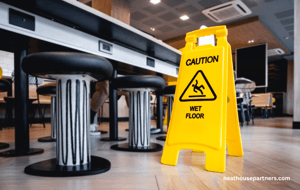What is the difference between COSHH and DSEAR?
What is the difference between COSHH (Control of Substances Hazardous to Health), and DSEAR (Dangerous Substances and Explosive Atmospheres Regulations). We explain their distinct roles, regulations and how they affect workplace safety.
James Rowland
Commercial Director James leads Account Management, Sales and Marketing at Neathouse Partners.Date
29 July 2024Updated
29 July 2024
Table of contents
Related articles
Tags
Businesses can become confused when it comes down to knowing which regulations to follow for substances with similar properties (but different classifications) under separate regulatory bodies. Both COSHH (Control of Substances Hazardous to Health) and DSEAR (Dangerous Substances and Explosive Atmospheres Regulations), require employers to assess hazards and control risks associated with handling, using, storing or transporting hazardous substances.
DSEAR states that employers must protect employees and the public from dangerous substances. This includes materials that are explosive, spontaneously combustible, flammable, corrosive, oxidising or highly reactive. These substances can be found in many workplaces, such as within products like paints, solvents, gases and dust. DSEAR requires the identification and classification of areas where 'explosive atmospheres' may occur, categorising these areas into zones and ensuring they are free from ignition sources through containment or protective systems.
What is DSEAR?
The Dangerous Substance and Explosive Atmospheres Regulations 2002 require employers to identify substances in their workplace that could pose fire, corrosion or explosion risks. This involves performing risk assessments on each work process and area to determine the presence and severity of potential hazards.
After assessing hazards and identifying risks, employers must decide whether each risk can be eliminated. If not, they should have appropriate control measures to reduce it. Given the severe risks associated with dangerous substances, it's crucial to have an emergency plan for every work area and to conduct regular risk assessments. This plan ensures that everyone can evacuate safely and contact emergency services should an incident occur.
Employees must be trained to recognise and report hazards and risks. For instance, certain processes or chemicals may release harmful fumes that remove oxygen from the air, creating health risks. Trained employees can enable prompt removal or control.
Employers must also regularly review and update all risk assessments and control measures. DSEAR mandates ongoing monitoring of exposure levels and health surveillance to ensure that exposure remains within acceptable limits.
What is COSHH?
The Control of Substances Hazardous to Health (COSHH) Regulations 2002 ensure the safe use and control of hazardous substances in the UK. Employers must protect anyone at their worksite from substances considered harmful to human health. This includes fumes, fibres, chemicals, vapours, nanoparticles and dust. These substances are found in almost all workplaces, whether in a factory or an office. For instance, dust on a computer or cleaning chemicals in a cupboard can also be considered hazardous.
Every hazardous substance and related working areas must be risk assessed to identify and control potential health risks. This also applies to substances produced in the workplace, such as fumes from smelting metals. Employers must regularly review and update all risk assessments and control measures.
COSHH regulations require continuous monitoring of exposure levels, employee training and health surveillance.
What is an example of an explosive atmosphere?

In DSEAR, an explosive atmosphere is a mix of dangerous substances with air (in normal conditions), that has the potential to explode when ignited. This includes gases, vapours, mist or dust that can cause combustion to spread. Normal conditions are temperatures from –20°C to 40°C and pressures from 0.8 to 1.1 bar.
Many industry workplaces have the ability to create explosive atmospheres. Examples include places where flammable gases or vapours are released, like vehicle paint spraying, or where fine dusts like grain flour or wood are handled.
Take for instance the example of a workshop where vehicle paint spraying takes place. In this environment, flammable paint vapours can mix with the air, and if an ignition source is introduced, it can cause an explosion that can cause fire to spread very quickly. Another example is a grain processing facility where fine dust from the grain can accumulate in the air, creating a potentially explosive atmosphere if ignited.
What do employers need to do?
DSEAR requires employers to eliminate or control risks from dangerous substances. Employers with workplaces where explosive atmospheres may occur have the following specific duties.
Classification of areas
Employers must classify areas where explosive atmospheres may occur into 'zones'. This classification depends on the likelihood of an explosive atmosphere. Misclassification can lead to unprotected areas igniting or unnecessary expenses due to over-rating a hazardous zone.
Selection of equipment and protective systems
Zoned areas must be protected from ignition sources. Equipment used in these areas must meet the standards of the Equipment and Protective Systems Intended for Use in Potentially Explosive Atmospheres Regulations 1996. Although this legislation was revoked in December 2016, it still applies to relevant products placed on the market or put into service prior to this date.
Existing equipment from before July 2003 can be used if a risk assessment deems it safe. Entry points to zoned areas should be marked with an ‘EX’ sign. Static electricity is a common ignition source, so proper earthing controls and anti-static clothing might be needed based on risk assessments.
Explosion safety

Before operating a workplace with zoned areas, employers must ensure that explosion safety measures are verified as safe by a competent person or organisation. While this can sometimes be done internally, employers must ensure they have the necessary expertise.
Who is responsible for a DSEAR assessment?
A DSEAR risk assessment involves identifying dangerous substances and potential explosive atmospheres in the workplace and creating control measures to manage these risks.
For example, if a business uses acetylene for welding, they must identify this as a risk in that it's a flammable gas, and take steps to either remove or control the risk.
The Health and Safety Executive (HSE) requires that a DSEAR risk assessment be conducted by a 'competent person.' A competent person would be a health and safety professional who understands the regulations, can assess risks, and can recommend appropriate control measures. This person should have thorough knowledge of DSEAR regulations. They should also have practical experience in conducting risk assessments for hazardous substances, and relevant qualifications in health and safety.
Employers should also train employees on how to manage and respond to the risks associated with dangerous substances and explosive atmospheres. Since DSEAR deals with substances that can cause fires and explosions, having competent assessors is crucial to ensuring the safety of employees and the public.
Is a DSEAR assessment a legal requirement?
Yes, DSEAR assessments are a legal requirement, and the regulations are enforced by the HSE and local authorities. Employers must assess and manage the risks of explosions caused by dangerous substances in the workplace. They must implement control and mitigation measures if these substances cannot be replaced with safer alternatives.
Since June 2015, DSEAR also covers risks from gases under pressure and substances corrosive to metal. These regulations align with changes in the EU Chemical Agents Directive.
We can advise on COSHH and DSEAR
Our team of professionals at Neathouse Partners can answer any questions you may have about COSHH and DSEAR, risk assessments and health and safety policies. Call us today on 0333 041 1094 or book in a call with one of our expert consultants.
Related blog posts

COSHH - The Basics Every Employer Needs to Know

Understanding the Noise at Work Regulations: A Guide for Employers

Health & Safety of Firework Displays: What Event Holders Must Know
Have questions?
Get in touch today
Contact us, and our team will get back to you within 24 hours. We value your questions and are committed to getting them answered quickly.


Hello! I am Nicky
Just fill in the form below with your details, and I will arrange for a member of our team to give you a call.
By clicking, you agree to our Privacy Policy





